African Americans Shut Out of Rhodes Scholarship Awards
 In 1907 Alain LeRoy Locke, later a major philosopher and literary figure of the Harlem Renaissance, was selected as a Rhodes scholar to study at Oxford University. It is generally believed that at the time of the award the Rhodes committee did not know that Locke was black until after he had been chosen. In 1907 Alain LeRoy Locke, later a major philosopher and literary figure of the Harlem Renaissance, was selected as a Rhodes scholar to study at Oxford University. It is generally believed that at the time of the award the Rhodes committee did not know that Locke was black until after he had been chosen.
It would be more than 50 years later, in 1962, that an African American would be named a Rhodes scholar. That year John E. Wideman, now a famed author as well as a professor at Brown University, was selected. Seven other blacks were named Rhodes scholars during the 1960s.
In the 1970s, approximately 25 African Americans received Rhodes scholarships. Noted African Americans who were Rhodes scholars in the 1970s include Randall Kennedy, professor of law at Harvard University, Kurt Schmoke, former mayor of Baltimore, and Franklin D. Raines, former director of the Office of Management and Budget and former CEO of Fannie Mae.
In 1978 Karen Stevenson of the University of North Carolina at Chapel Hill was the first African-American woman selected as a Rhodes scholar.
In the 1980s, when America took a conservative turn and affirmative action pressures diminished, fewer black candidates were chosen for the Rhodes scholarship program. But in the 1990s and so far in the twenty-first century, the norm has been for one or two African Americans to be named each year to Rhodes scholarships. But this year, there were no blacks among the 32 Americans awarded Rhodes scholarships.
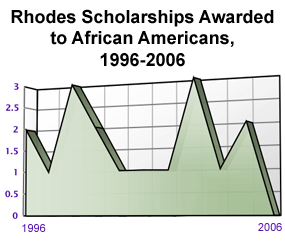
  |
“I am inclined to see Ward Connerly as an opportunist, someone who is supported by wealthy backers and is primarily interested in protecting the privileged, not the underprivileged. He has set us back 30 years in terms of public education.”
 — Darnell Hunt, professor of sociology and director of the Ralph J. Bunche Center for African American Studies at UCLA, commenting on Ward Connerly’s plans to place anti-affirmative action initiatives on the ballot in several more states, in the Los Angeles Times, November 26, 2006 — Darnell Hunt, professor of sociology and director of the Ralph J. Bunche Center for African American Studies at UCLA, commenting on Ward Connerly’s plans to place anti-affirmative action initiatives on the ballot in several more states, in the Los Angeles Times, November 26, 2006
|
Civil Rights Project Moving From Harvard to UCLA
 The Civil Rights Project, based for the past 10 years in the Graduate School of Education at Harvard University, is moving to the University of California at Los Angeles. Professor Gary Orfield, the director of the center, will take a faculty position at UCLA. The Civil Rights Project, based for the past 10 years in the Graduate School of Education at Harvard University, is moving to the University of California at Los Angeles. Professor Gary Orfield, the director of the center, will take a faculty position at UCLA.
The Civil Rights Project has been a leading voice on the persistence of racial segregation in the nation’s public schools. Orfield’s research has consistently shown that public schools, particularly in the North, are more racially segregated than was the case 20 years ago.
Professor Orfield stated that it had become increasingly difficult for him to run the center since his cofounder, Christopher Edley Jr., left three years ago to become dean of the Boalt Hall Law School at the University of California.
For Tens of Thousands of Black Teenage Mothers, a College Education Is Only a Distant Dream
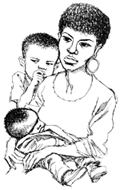 The cost of higher education and the lack of adequate financial aid make it difficult for many young Americans to even consider a college education. Having a baby as a teenager also makes it extremely difficult to juggle college and family responsibilities, and to meet the financial obligations to provide for one’s child and also to pay for college. The cost of higher education and the lack of adequate financial aid make it difficult for many young Americans to even consider a college education. Having a baby as a teenager also makes it extremely difficult to juggle college and family responsibilities, and to meet the financial obligations to provide for one’s child and also to pay for college.
Black women in their teenage years have made tremendous progress in lowering their birth rates. But a large racial gap remains.
New data from the National Center for Health Statistics shows a dramatic drop in births by black teenagers. In 1991 the fertility rate shows that there were 86.1 births for every 1,000 black teenage women between the ages of 15 and 17. By 2005 there were only 34.9 births for every 1,000 black teenage women in this age group. Thus, the black teenage fertility rate for this age group has been cut by more than one half in the past 15 years. However, black women in this age group remain three times as likely as their white peers to give birth.
For blacks in the 18 to 19 age group, the fertility rate in 1991 was 162.2 per 1,000 women. In 2005 the fertility rate dropped to 102.9 for every 1,000 black women in this age group. Despite this major drop in fertility rates among blacks ages 18 and 19, blacks in this age group are still twice as likely as similarly aged whites to give birth.
For the vast majority of black teenage mothers, a college education is not considered in the realm of possibilities.

University of Wyoming

Early Childhood Education: Birth to Eight (Assistant/Associate Professor) Tenure-Track Position
The successful candidate for this experience will have a holistic understanding of the content, contexts, and processes of developmentally and culturally appropriate educational practices for children birth-eight years; partnerships with families and children representing diverse populations (ability, culture, language); interdisciplinary collaboration in preparing early childhood professionals; community needs for support in providing statewide quality early care and education. Responsibilities: teach undergraduate and graduate courses in early childhood education on-campus and through distance delivery; advise undergraduate students and mentor graduate students; establish a productive research agenda; engage in service outreach and travel consistent with a land grant university. Qualifications: Earned doctorate with an emphasis in early childhood education (birth-eight), effective communication skills, and a minimum of three years experience teaching young children. Preference will be given to those with a publication record, successful teaching in higher education and experience with distance education. Apply to Dr. Michelle Buchanan (307) 766-3211 or mlbuchan@uwyo.edu.
The University of Wyoming College of Education is strongly committed to attracting a diverse pool of faculty where cultural experiences and competencies are valued. More information is available at the College's website http://ed.uwyo.edu. The University of Wyoming is an Affirmative Action, Equal Opportunity employer.

High-Ranking Institutions With Low Black Student Graduation Rates
In last week’s edition, JBHE named the colleges and universities with the nation’s highest black student graduation rates. Harvard, Princeton, Amherst, Wellesley, and Williams all report black student graduation rates of at least 94 percent.
 Among the nation’s colleges and universities that are commonly rated as selective, the lowest black student graduation rate occurs at Carleton College in Minnesota. Only 66 percent of the black freshmen who enroll at Carleton College go on to graduate. Among the high-ranking universities, the lowest black student graduation rate is at Carnegie Mellon University in Pittsburgh. But the number of black students at Carnegie Mellon is not large. The curriculum at Carnegie Mellon is heavily directed toward science. This may be a factor in the relatively low graduation rate of black students. Among the nation’s colleges and universities that are commonly rated as selective, the lowest black student graduation rate occurs at Carleton College in Minnesota. Only 66 percent of the black freshmen who enroll at Carleton College go on to graduate. Among the high-ranking universities, the lowest black student graduation rate is at Carnegie Mellon University in Pittsburgh. But the number of black students at Carnegie Mellon is not large. The curriculum at Carnegie Mellon is heavily directed toward science. This may be a factor in the relatively low graduation rate of black students.
Far more disturbing is the poor black student graduation rate at the academically selective University of Michigan. This is a huge state university of 40,000 students. And performance there is a national bellwether. Only 68 percent of entering black students at the University of Michigan go on to graduate. Currently there are nearly 1,900 black students at the University of Michigan, the largest black enrollment of any high-ranking college or university. If these black students graduate at the same rate as their peers in the recent past, about 600 of them will fail to earn their bachelor’s degree.
Gender Gap in African-American Enrollments at Black Colleges
 The latest data shows that there are 1,266,107 black women enrolled in higher education compared to 686,615 black men. Recently JBHE surveyed eight of the nation’s most prestigious privately operated coeducational black colleges and universities to see if women at these schools hold the same very large lead over black men as do black women on the national level. The latest data shows that there are 1,266,107 black women enrolled in higher education compared to 686,615 black men. Recently JBHE surveyed eight of the nation’s most prestigious privately operated coeducational black colleges and universities to see if women at these schools hold the same very large lead over black men as do black women on the national level.
We found that black women make up a majority of the student body at each of the institutions surveyed. At Dillard University, women make up 78 percent of the student body. At Clark Atlanta and Xavier, women make up more than 70 percent of all students. Even at Tuskegee University, which is known for its strong programs in the agricultural sciences (a discipline not considered to be a favorite course of study among women), women are now a majority of the student body.
  |
25.4% The percentage of all white women in the U.S. who gave birth in 2005 who were not married.
69.5% The percentage of all African-American women who gave birth in 2005 who were not married.
source: National Center for Health Statistics
|
Report Finds That Large Numbers of Black Students at Duke Face Discrimination in the Classroom and Also Elsewhere on Campus
 The Campus Life and Learning Project at Duke University asked students who graduated from the university in 2005 and 2006 about their lives on campus during their freshman and sophomore years. The data showed that 44 percent of the black students reported being the victims of some sort of racial discrimination or abuse either in the classroom, residence hall, or elsewhere on campus. One in seven black students said that their instructors or professors “treated them badly because of their race.” The Campus Life and Learning Project at Duke University asked students who graduated from the university in 2005 and 2006 about their lives on campus during their freshman and sophomore years. The data showed that 44 percent of the black students reported being the victims of some sort of racial discrimination or abuse either in the classroom, residence hall, or elsewhere on campus. One in seven black students said that their instructors or professors “treated them badly because of their race.”
The study also found that the average grade point average for black students at Duke during their freshman and sophomore years was 2.97. This compared to an average GPA for whites of 3.30.

University of Arkansas

Assistant Director – Family And Consumer Sciences
The University of Arkansas Division of Agriculture, Cooperative Extension Service (CES) seeks a dynamic and visionary leader for the position of Assistant Director – Family and Consumer Sciences (FCS) in Little Rock, Arkansas. Little Rock, the capital city, is located in the center of the state on the banks of the Arkansas River.
The University of Arkansas’ Division of Agriculture CES faculty and staff provide educational programs and research-based information to Arkansans in 75 counties. This non-tenure track faculty position is part of the Executive Team of the Associate Vice President for Agriculture – Extension.
The Assistant Director – FCS provides state-wide leadership for Extension programs in Family and Consumer Science, supervises state FCS personnel, directs the development of FCS educational curricula, and works closely with other CES units in the administration of programs. The Assistant Director – FCS coordinates budgets within FCS programs and seeks external financial support for educational programs.
Required qualifications: Doctorate in Family and Consumer Sciences or related field from an accredited college or university. A minimum of five (5) years of experience with demonstrated leadership, team building, administrative and grantsmanship capabilities in FCS preferred.
The vacancy posting can be viewed at http://jobs.uaex.edu.
Interested candidates should submit a letter of interest, curriculum vita, transcripts, and three (3) professional letters of reference to:
Dr. Ivory Lyles
Associate Vice President for Agriculture - Extension
2301 South University Ave., Room 208D
P.O. Box 391
Little Rock, AR 72203
Phone: 501-671-2001
Fax: 501-671-2107
E-mail: ilyles@uaex.edu

Black Enrollments on the Rise at Connecticut’s Community Colleges
 New data from the Connecticut Community College System shows that there are nearly 47,000 students enrolled at the system’s 12 campuses. The system has had eight straight years of enrollment growth. New data from the Connecticut Community College System shows that there are nearly 47,000 students enrolled at the system’s 12 campuses. The system has had eight straight years of enrollment growth.
The study found that minority students are fueling the growth in total enrollments. Since 2002, minority enrollments are up 13 percent, with Hispanic women accounting for the largest increase. Enrollments of black women are up 10 percent since 2002 and black male enrollments have increased by 5 percent. More than 60 percent of all minority students in Connecticut’s state-operated colleges and universities are now enrolled at two-year community colleges.
There are now more than 7,200 black students at Connecticut community colleges. They make up 15.5 percent of the total enrollments. Blacks are about 9 percent of the Connecticut population.
Black women make up two thirds of all African-American enrollments at Connecticut community colleges.
In Memoriam
Bebe Moore Campbell (1950-2006)
 Bebe Moore Campbell, a trustee of the University of Pittsburgh who the Washington Post called one of the most important African-American writers of the twentieth century, has died in Los Angeles from brain cancer. She was 56 years old. Bebe Moore Campbell, a trustee of the University of Pittsburgh who the Washington Post called one of the most important African-American writers of the twentieth century, has died in Los Angeles from brain cancer. She was 56 years old.
Campbell was the author of nine books, many of them best sellers. Two of her books — Brothers and Sisters and Sweet Summer — were made into feature films. She was a frequent contributor to Ebony, Essence, and Black Enterprise and was a commentator on National Public Radio.
A 1971 graduate of the University of Pittsburgh with a degree in education, Campbell worked as an elementary school teacher for three years before embarking on her writing career. She was appointed to the University of Pittsburgh’s board of trustees in June 2005.
William Jimmerson Holloway (1917-2006)
William Jimmerson Holloway, author, editor, and educator, died late last month from heart failure at a nursing home in Chevy Chase, Maryland. He was 89 years old.
Dr. Holloway taught at Savannah State University, North Carolina Central University, and finally at Ohio State University. At Ohio State he also served as vice provost for minority affairs. There he founded the Nigerian Education Program, which during his tenure awarded 181 degrees to Nigerians who returned to Africa to serve as teachers. He retired from Ohio State in 1978 and at that time was named professor emeritus.
Professor Holloway also served as editor in chief of the Negro Educational Review. He authored two books: The Education of Blacks in Virginia Before the Civil War, 1619-1960, and his 2001 autobiography, The Odyssey of a North American Educator.
A native of Smithfield, Virginia, Holloway was a 1940 graduate of Hampton University. He held a master’s degree from the University of Michigan and a doctorate in educational administration from the University of Illinois.

Northeastern University

Senior Scholar, Department of African-American Studies
The Department of African-American Studies at (www.afrostudies.neu.edu) seeks a senior, policy-oriented, social scientist for a new tenured position authorized by the College of Arts and Sciences beginning in September 2007. Ph.D in an appropriate field is required. Candidates should also have a well-established record of excellence in scholarship, teaching, and service, commensurate with appointment at the rank of Associate Professor. The successful candidate should be able to provide dynamic energy to help advance our reinvigorated efforts to consolidate the Department’s undergraduate program, develop a new graduate program, and expand research initiatives focusing on social policy and Black community development. Competitive salary, benefits, and start-up funds will be offered.
The Department, chaired by Professor Robert Hall, has just celebrated its 30th anniversary and is poised for growth and further development in Boston, known for its vibrant institutions of higher education and its diverse communities. While the emphasis for this position is the United States, our faculty includes an interdisciplinary core in African-American Studies, joint appointments in related disciplines, and a strong Africana focus (Africa, Caribbean, South America). Special activities include a symposium honoring Fannie Lou Hamer and the Mississippi Freedom Democratic Party (during the 2004 Democratic National Convention); an Annual John Coltrane Concert; archaeology and education projects on Ancient Nubia; student participation in annual national Model African Union activities; and a range of other public history, research, and community development initiatives.
Please submit resumes by December 31, 2006 to Kwamina Panford by e-mail, k.panford@neu.edu, or mail to Department of African-American Studies, Northeastern
University, 360 Huntington Avenue, Boston, MA 02115.
Northeastern University is an Equal Opportunity, Affirmative Action Educational Institution and Employer, Title IX University, and particularly welcomes applications from minorities, women, and persons with disabilities.

Award
 • James P. Comer, Maurice Falk Professor of Child Psychiatry at Yale University School of Medicine, won the 2007 Grawemeyer Award for education from the University of Louisville. Comer was honored for his book, Leave No Child Behind: Preparing Today’s Youth for Tomorrow’s World. The award comes with a cash prize of $200,000. • James P. Comer, Maurice Falk Professor of Child Psychiatry at Yale University School of Medicine, won the 2007 Grawemeyer Award for education from the University of Louisville. Comer was honored for his book, Leave No Child Behind: Preparing Today’s Youth for Tomorrow’s World. The award comes with a cash prize of $200,000.
Professor Comer, the author of nine books, is a graduate of Indiana University. He holds a master’s degree in public health from the University of Michigan and a medical degree from Howard University. He has been a member of the faculty at Yale since 1968.
|
Major Decline in Doctoral Degree Awards to African Americans
Usually, at this time of year, we have been in a position to report major gains in black doctoral awards. Since JBHE was first published in 1993, we have reported almost a continuous and often major increase in the number of blacks earning doctorates. For both the years 2003 and 2004 we were able to report that the number of African Americans awarded doctorates had reach all-time highs.
But a new report prepared by the National Opinion Research Center at the University of Chicago finds a decline. In 2005, there were 1,688 African Americans who earned doctorates. This was a very large decrease of nearly 10 percent from 2004. It was only the third time in the past 20 years that the number of black doctorates had declined from the previous year.
In 2005 blacks made up 6.4 percent of all doctorates awarded to American citizens. In 2004 blacks were 7.1 percent of all doctoral recipients, at that time the highest level ever achieved.
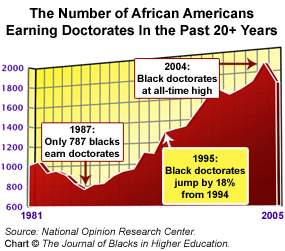

Eastern Washington University

College of Science, Health and Engineering
Department of Physical Therapy
The Department of Physical Therapy invites applications for a nine-month, full-time, tenure-track position beginning September, 2007. The position will be offered at the Assistant/Associate Professor level depending on qualifications. The Department of Physical Therapy offers the entry-level Doctor of Physical Therapy (DPT) and is located in a state-of-the-art Health Sciences Building located on the Spokane River in downtown Spokane. The city of Spokane, located in the Inland Northwest, has been rated 2nd in the nation for having the best summer weather. Recreational, social, and cultural opportunities are numerous.
Candidates must have a post professional doctoral degree (PhD or DSc), be eligible for licensure in the state of Washington, have a minimum of five years of clinical experience in Physical Therapy, teaching experience at the graduate level, and a high degree of interest in human and cultural diversity. Candidates will be expected to teach in their area of expertise, team teach in clinical research courses and contribute to other courses as needed. Research in the candidate’s area of interest and service to the department, university and profession are expected.
Candidates must submit a letter of application, current curriculum vitae, and names of three persons who can be contacted for references. Review of the candidates will begin immediately and will continue until the position is filled. The successful candidate will be required to pass a background check and show proof of eligibility to work in the US pursuant to US immigration laws.
Letter of application and curriculum vitas should be submitted to:
Byron Russell, PT, PhD
Chair, Department of Physical Therapy
Eastern Washington University
310 North Riverpoint Blvd, Box T
Spokane, WA 99202-0002
Tel: (509) 368-6608
E-mail: byron.russell@mail.ewu.edu
EWU is an Equal Opportunity/Affirmative Action Employer, and applications from members of historically underrepresented groups are especially encouraged.

Very Few African Americans Sit for the SAT II Tests
Each year nearly 1.5 million high school students take the basic Scholastic Assessment Test (SAT). A much smaller group also sit for the more rigorous SAT II subject examinations.
In 2006, 279,428 high school seniors nationwide took at least one SAT II subject test. Within this group there were 13,398 black students who took one or more SAT II tests. Therefore, blacks made up only 4.8 percent of all students who took at least one of the SAT subject tests. Looking at the racial gap another way, we find that only 8.0 percent of all black students who took the standard or regular SAT also took one or more of the SAT II tests. In contrast, 15.2 percent of the white students who took the SAT I also took one or more SAT II tests. Therefore, college-bound black students are about one half as likely as white students to take the SAT II subject tests.
The racial shortfall is explained in large part by the fact that many of the colleges and universities to which the vast majority of black students apply do not require SAT II tests. Generally, only the nation’s most selective colleges and universities require applicants to submit scores on SAT II tests. Most public universities and historically black colleges do not require the SAT II test.
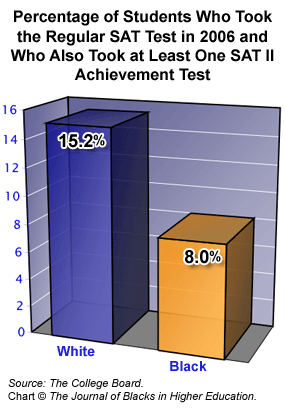
A Decade After African Americans Graduate From College: Where They Stand on Marriage, Voting Behavior, and Home Ownership
Recently, the U.S. Department of Education surveyed a group of black and white students who graduated from college in 1993. The survey explored how the students have fared on a wide variety of economic, educational, and social fronts since they earned their bachelor’s degree. Here are some of the highlights:
• More than 70 percent of the white 1992-93 college graduates were married in 2003. Only 52 percent of the African Americans who graduated from college in 1992-93 were married a decade later. A full one third of these African-American college graduates had never been married, compared to only 18 percent of white college graduates.
• Nearly 77 percent of 1992-93 white college graduates owned their home in 2003. For blacks who graduated from college in 1992-93, only 58.6 percent owned their home.
• Blacks with a college degree were slightly more likely than their white peers to have registered to vote. Nearly 85 percent of African Americans who graduated from college in 1992-93 voted in the 2002 midterm elections. For whites, 77 percent of 1992-93 college graduates voted in the 2002 elections. More than 21 percent of African-American college graduates attended political meetings or rallies compared to 15 percent of white college graduates.
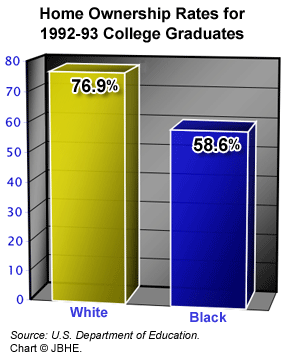

University of North Carolina Wilmington

Assistant Vice Chancellor for Resource Management
Reporting to the Vice Chancellor for Academic Affairs, the incumbent is responsible for analysis, quality assurance, planning, and forecasting relative to the division’s annual and biennial budgets; developing division- wide guidelines for the allocation of new resources; and advising the Vice Chancellor for Academic Affairs on the most effective alignment and utilization of existing resources to support the instructional, research and public service mission of the division. UNCW has approximately 12,000 students and is located in the southeastern region of North Carolina, near the historic district of Wilmington, four miles from the Cape Fear River and five miles west of Wrightsville Beach and the Atlantic Ocean. For more information including qualification and application instructions, please visit http://consensus.uncw.edu. Priority consideration will be given to online applications received by January 2, 2007 but will be accepted until the position is filled.
UNCW is an Equal Opportunity/Affirmative Action employer. Women and minorities are especially encouraged to apply.

Poll Shows Brown University Students Turn a Cold Shoulder to Report on the Institution’s Involvement With the Slave Trade
A poll conducted by the Brown Daily Herald found that nearly 45 percent of the students at Brown University had not heard about or were not interested in the report of the University Steering Committee on Slavery and Justice. Only 18 percent of Brown students said that they had read or planned to read the entire report.
The report found that slaves had helped construct buildings on campus and that the Brown family, who provided much of the money for the establishment of the university, was involved in the slave trade. The report also made recommendations on how the university should make amends for its involvement in the slave trade.

The poll also asked students how they felt about some of the recommendations for making amends. Nearly 60 percent of Brown students supported the establishment of a center for the study of slavery on campus. But less than half of all Brown students supported the erection of a memorial to slaves on campus. Only 44 percent supported efforts to increase enrollments of black students from Africa and Caribbean nations.
New Education Department Building in New Jersey Named for Robert L. Carter, Key Figure in the Brown v. Board of Education Case
 The New Jersey Department of Education Building in Trenton has been renamed to honor Judge Robert L. Carter. He is now 89 years old and still serves on the federal bench. Carter was a key lieutenant of Thurgood Marshall at the NAACP Legal Defense Fund during the 1940s and 1950s when the critical legal battles were fought to end racial segregation in higher education and the nation’s public schools. The New Jersey Department of Education Building in Trenton has been renamed to honor Judge Robert L. Carter. He is now 89 years old and still serves on the federal bench. Carter was a key lieutenant of Thurgood Marshall at the NAACP Legal Defense Fund during the 1940s and 1950s when the critical legal battles were fought to end racial segregation in higher education and the nation’s public schools.
Robert Carter was born in Florida but was raised in northern New Jersey. After graduating from Barringer High School in Newark, he enrolled at Lincoln University in Pennsylvania. He later would earn a law degree at Howard University and a master’s degree in law from Columbia University.
In cases leading up to Brown v. Board of Education, Carter argued 22 cases before the Supreme Court. He won 21 times. Carter argued three of the five preliminary cases in the district courts which were combined to form the Brown case. Young Linda Brown, whose name later became synonymous with the battle to end racial segregation in schools, never met Thurgood Marshall. It was Robert Carter who handled her case in Topeka, Kansas.
Carter was appointed to the federal bench by President Nixon in 1972. He still serves as a senior judge. Over the years he has held adjunct teaching positions at the law schools of Yale, New York University, and the University of Michigan. In 2000 he was named to the Haywood Burns Chair in Civil Rights at the City University of New York School of Law.
Grading the States on Their Progress in Achieving Racial Diversity at Their Flagship Universities
 A new report from the Educational Trust, a non-profit Washington-based educational think tank, finds that blacks and other minority students are not faring well at the flagship state universities. Blacks, Latinos, and American Indians make up 24 percent of all college students nationwide, but they constitute only 12 percent of the first-year enrollments at the nation’s 50 flagship state universities. For those black students who enroll at these institutions, about 58 percent go on to earn their diplomas within six years. For whites at these universities, the graduation rate is 69 percent. A new report from the Educational Trust, a non-profit Washington-based educational think tank, finds that blacks and other minority students are not faring well at the flagship state universities. Blacks, Latinos, and American Indians make up 24 percent of all college students nationwide, but they constitute only 12 percent of the first-year enrollments at the nation’s 50 flagship state universities. For those black students who enroll at these institutions, about 58 percent go on to earn their diplomas within six years. For whites at these universities, the graduation rate is 69 percent.
The report examined six criteria such as minority enrollment compared to the percentage of minority high school graduates in the state and the minority college graduation rate compared to the white rate. The report developed a final grade for all 50 flagship state universities. Not one university received a grade of A. Seven received grades of F. They are the University of Arkansas, the University of Arizona, the University of Illinois, the University of Mississippi, the University of North Dakota, Pennsylvania State University, and the University of Rhode Island.

University of Rochester

Provost
The University of Rochester, one of the nation’s premier private research universities, seeks a provost to join its new president and newly formed leadership team in realizing an ambitious and exciting vision for the institution’s future. Reporting to and working closely with President Joel Seligman, the provost will be the chief academic officer of the University of Rochester, as well as a member of the University’s Senior Leadership Team. Within this highly decentralized university, the provost has a prominent role in promotion and tenure and in decanal reviews. He or she will provide leadership for initiatives including strategic planning, technology transfer, interdisciplinary collaboration, and diversity. The successful candidate will be a research scholar and academic administrator of considerable experience and proven success. He or she must have the skills and personal qualities necessary to be an active and energetic partner to the president, and participant in institutional growth.
Inquiries, nominations and applications are invited. Review of applications will begin on January 15 and will continue until the position is filled. The position specification is available upon request and should be reviewed by candidates before preparing application materials. These materials should be sent electronically via e-mail to the University of Rochester’s consultants, Jean Dowdall, Ph.D., Alexander (Sandy) Williams and Elizabeth Bohan, at RochesterProvost@wittkieffer.com. Documents that must be mailed may be sent to Witt/Kieffer, 2015 Spring Road, Suite 510, Oak Brook, IL 60523. The consultants can be reached by telephone at (630) 575-6131.
The University of Rochester values diversity and is committed to equal opportunity for all persons regardless of age, color, disability, ethnicity, marital status, national origin, race, religion, sex, sexual orientation, veteran status or any other status protected by law.

Appointments
• Valencia Thomas was appointed assistant professor of dermatology at the Yale University School of Medicine. She was a Mohs Surgery Fellow in the dermatologic surgery unit at the Oregon Health and Science University. Dr. Thomas earned her medical degree at the University of Chicago.
 • Michelle Carter was promoted to interim director of research and sponsored programs at the Mankato campus of Minnesota State University. She was the director of the Ronald E. McNair Post-Baccalaureate Achievement Programs. • Michelle Carter was promoted to interim director of research and sponsored programs at the Mankato campus of Minnesota State University. She was the director of the Ronald E. McNair Post-Baccalaureate Achievement Programs.
Carter is a graduate of Xavier University in New Orleans. She holds a master’s degree from Northwestern University and a law degree from the Southern University Law Center.
 • Carlos R. Clark was named assistant provost for student financial aid at Prairie View A&M University in Texas. He was director of financial aid at Alabama A&M University. He holds a bachelor’s, master’s, and educational doctorate from the University of Mississippi. • Carlos R. Clark was named assistant provost for student financial aid at Prairie View A&M University in Texas. He was director of financial aid at Alabama A&M University. He holds a bachelor’s, master’s, and educational doctorate from the University of Mississippi.
Grants
• Hampton University, the historically black educational institution in Virginia, received a $100,000 grant from the accounting firm Ernst & Young. The grant will be used for student scholarships and to enhance the technological assets of the university’s business school.
 • Spelman College, the historically black educational institution for African-American women in Atlanta, received a $140,000 grant from the Arcus Foundation. The college will use the grant to archive the papers of Audre Lorde, one of the most influential African-American feminist writers of the twentieth century. The papers include poems, manuscripts, journal entries, letters, and essays. Lorde died in 1992 and left her papers to Spelman College but her estate requested that the collection remain closed until an authorized biography of Lorde was completed. • Spelman College, the historically black educational institution for African-American women in Atlanta, received a $140,000 grant from the Arcus Foundation. The college will use the grant to archive the papers of Audre Lorde, one of the most influential African-American feminist writers of the twentieth century. The papers include poems, manuscripts, journal entries, letters, and essays. Lorde died in 1992 and left her papers to Spelman College but her estate requested that the collection remain closed until an authorized biography of Lorde was completed.
|
 .
.